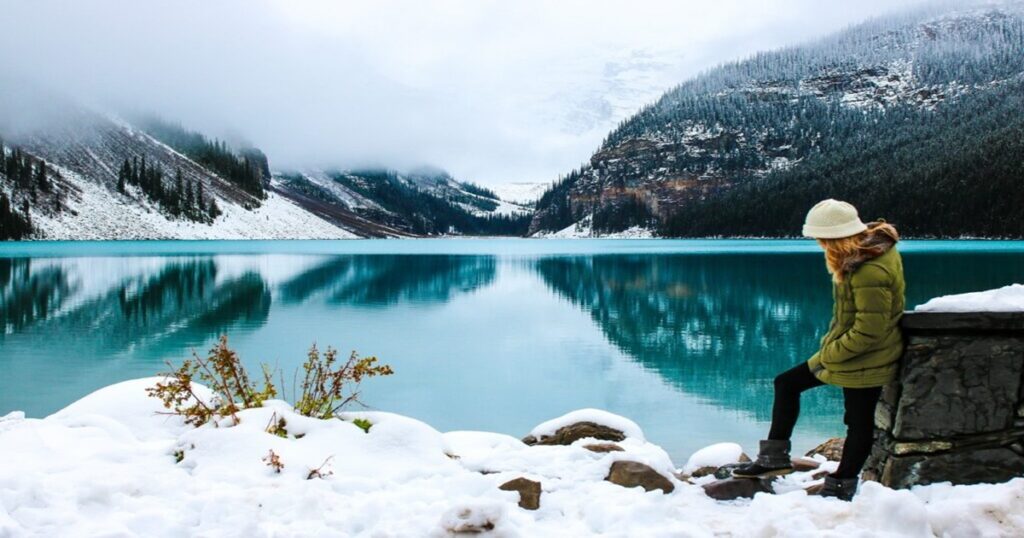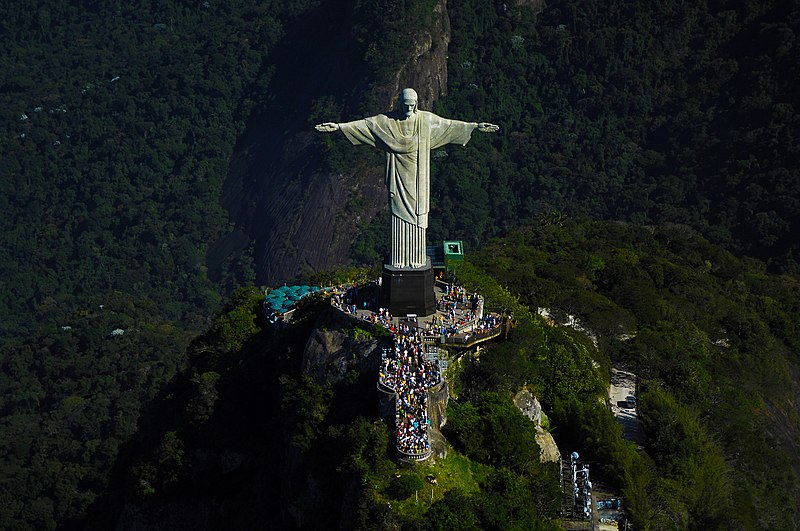BEST TIME TO VISIT BANFF
Post Highlights
- 1 Introduction of Banff:
- 2 Banff is Famous for:
- 3 All the nearby places of Banff to visit with distance:
- 4 Itinerary to Visit Banff and Nearby Places:
- 5 How to Reach Banff:
- 6 Best Hotels of Banff:
- 7 Best Time to Visit Banff:
- 8 Local Culture & Cuisine of Banff:
- 9 Activities to Do in Banff:
- 10 Banff Travel Budget for a Couple:
- 11 Banff Reviews of Travelers Positive and Negative:
- 12 Traveling with Family or Solo to Banff:
- 13 What to Carry with You:
- 14 Important Instructions:
- 15 Warnings:
- 16 Conclusion:
Introduction of Banff:
Banff, Nestled between the majestic mountains and the Pacific Ocean, Vancouver stands as a beacon of multiculturalism, natural beauty, and urban sophistication. This vibrant city in British Columbia, Canada, has captured the hearts of travelers worldwide. In this comprehensive guide, we will take you on a virtual tour of Vancouver, covering everything from its renowned attractions to local cuisine, ensuring that your visit to this Canadian gem is nothing short of extraordinary.
Banff is Famous for:
Vancouver boasts a unique blend of diverse cultures, stunning landscapes, and a thriving arts scene. Known for its breathtaking scenery, the city is framed by the Coast Mountain Range and the Pacific Ocean, providing a picturesque backdrop for your adventures. Moreover, Vancouver is celebrated for its commitment to sustainability, making it one of the greenest cities globally.
Explore: Vancouver
All the nearby places of Banff to visit with distance:
1. Lake Louise

- Distance from Banff: Approximately 36 km (22 miles)
- Highlights: Iconic turquoise lake, hiking trails, and the Fairmont Chateau Lake Louise.
Nestled within the heart of Banff National Park, Lake Louise is renowned for its stunning turquoise waters and picturesque mountainous surroundings. The lake is set against the backdrop of Victoria Glacier, creating a postcard-perfect scene that attracts visitors from around the globe. Beyond its aesthetic charm, Lake Louise offers a variety of outdoor activities, including hiking, canoeing, and in the winter, ice skating. The Fairmont Chateau Lake Louise, an iconic hotel, sits on the lake’s eastern shore, providing a luxurious and memorable accommodation experience for those seeking a unique stay in the midst of unparalleled natural beauty.
2. Moraine Lake
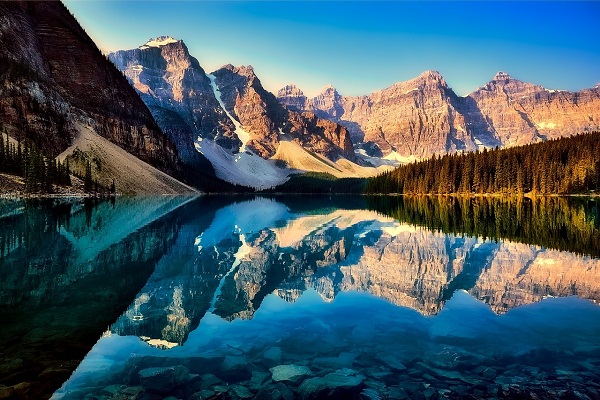
- Distance from Banff: Approximately 60 km (37 miles)
- Highlights: Spectacular glacial-fed lake, surrounded by mountains, and the Valley of the Ten Peaks.
Moraine Lake, often referred to as the “Jewel of the Rockies,” is a gem nestled in the Valley of the Ten Peaks within Banff National Park. The lake’s vibrant turquoise color, fed by glacial melt, captivates visitors. Surrounded by towering peaks and offering hiking trails, Moraine Lake provides a serene escape into the Canadian Rockies. Rockpile Trail provides a vantage point for breathtaking panoramic views of the lake and surrounding mountains, making Moraine Lake a must-visit destination for nature enthusiasts and photographers alike.
3. Jasper National Park
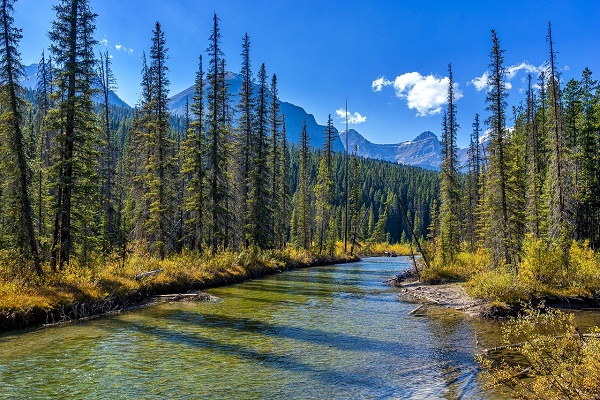
- Distance from Banff: Approximately 290 km (180 miles)
- Highlights: Stunning mountain scenery, glaciers, wildlife, and the Icefields Parkway.
Stretching north of Banff, Jasper National Park is the largest national park in the Canadian Rockies, celebrated for its pristine wilderness and abundant wildlife. From the famous Columbia Icefield to the soothing waters of Maligne Lake, the park boasts diverse landscapes. Visitors can explore the stunning Athabasca Falls, relax in the Miette Hot Springs, and marvel at the Dark Sky Preserve, where stargazing opportunities are unparalleled. Jasper’s quieter and more remote atmosphere provides a tranquil contrast to the bustling town of Banff, appealing to those seeking a more secluded mountain retreat.
4. Yoho National Park

- Distance from Banff: Approximately 130 km (81 miles)
- Highlights: Takakkaw Falls, Emerald Lake, and natural wonders like the Burgess Shale fossil beds.
Yoho National Park, located just across the border in British Columbia, showcases awe-inspiring scenery and natural wonders. Notable attractions include the stunning Takakkaw Falls, one of Canada’s highest waterfalls, and the mesmerizing Emerald Lake, surrounded by towering mountain peaks. The Burgess Shale fossil beds also make Yoho a UNESCO World Heritage Site, attracting paleontologists and nature enthusiasts alike. With its diverse landscapes, Yoho National Park offers a refreshing blend of alpine lakes, waterfalls, and dense forests, making it an essential stop for those exploring the Canadian Rockies.
5. Kananaskis Country
- Distance from Banff: Varies, as it covers a large area adjacent to Banff National Park
- Highlights: Hiking, biking, and scenic drives, with highlights like Kananaskis Village and Spray Lakes.
Often considered a hidden gem, Kananaskis Country is a less-crowded but equally breathtaking destination situated southwest of Banff National Park. The region boasts a vast expanse of pristine wilderness, featuring rugged mountains, alpine meadows, and crystal-clear lakes. Outdoor enthusiasts can indulge in activities such as hiking, mountain biking, and horseback riding. Kananaskis Country provides a tranquil retreat for those seeking a quieter alternative to the more bustling tourist areas, all while maintaining the stunning natural beauty that defines the Canadian Rockies.
Read Also About: San Miguel de Allende
6. Banff National Park's Icefields Parkway
- Distance from Banff: Starts within the park
- Highlights: Scenic highway with glaciers, waterfalls, and wildlife. Connects Banff and Jasper National Parks.
The Icefields Parkway, a scenic highway winding through Banff and Jasper National Parks, is often regarded as one of the most breathtaking drives in the world. Connecting Lake Louise and Jasper, this 144-mile stretch offers unparalleled views of glaciers, pristine lakes, and rugged mountain peaks. Travelers can witness the vast Columbia Icefield, with opportunities to explore the Athabasca Glacier. The Icefields Parkway is not just a roadway; it’s a journey through some of the most spectacular landscapes in the Canadian Rockies, making each turn a new opportunity for awe-inspiring vistas.
7. Bow Lake

- Distance from Banff: Approximately 50 km (31 miles)
- Highlights: Beautiful glacial lake along the Icefields Parkway, with hiking trails and stunning views.
Situated along the Icefields Parkway, Bow Lake captivates visitors with its stunning turquoise waters, reflecting the surrounding glaciers and mountains. This glacial-fed lake offers a tranquil setting for picnics, leisurely strolls, and photography. The iconic Crowfoot Glacier, resembling a three-toed crow’s foot, adds to the dramatic scenery. Bow Lake provides a serene stop for travelers journeying along the Icefields Parkway, allowing them to soak in the natural beauty of the Canadian Rockies.
8. Sulphur Mountain
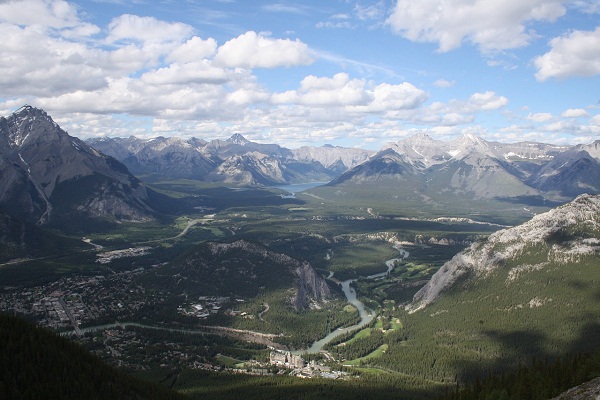
- Distance from Banff: In Banff town
- Highlights: Banff Gondola to the summit for panoramic views, hiking trails, and the Banff Upper Hot Springs.
Offering panoramic views of the Bow Valley and Banff townsite, Sulphur Mountain is a prominent peak accessible by the Banff Gondola. Visitors can ascend the mountain effortlessly and enjoy the breathtaking scenery from the summit. Sulphur Mountain also boasts a network of hiking trails for those seeking a more active adventure. The Banff Upper Hot Springs, located at the base of the mountain, provide a relaxing soak with stunning mountain views. Sulphur Mountain is a must-visit destination for those wanting to experience the grandeur of the Rockies from a lofty perspective.
9. Vermilion Lakes
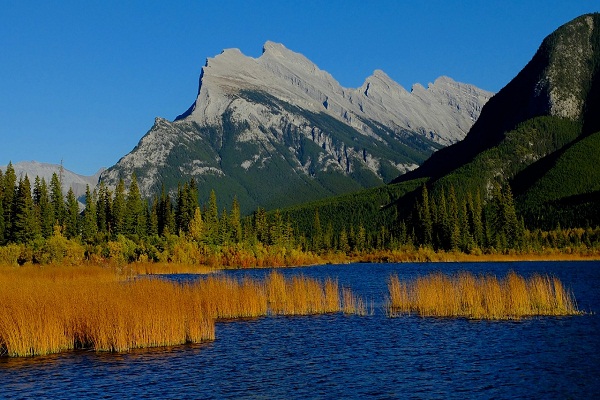
- Distance from Banff: In and around Banff
- Highlights: Scenic lakes with reflections of the surrounding mountains, popular for photography.
A series of three interconnected lakes just west of Banff, the Vermilion Lakes offer a tranquil escape with stunning views of Mount Rundle. The lakes’ calm waters reflect the surrounding mountains and provide a haven for birdwatchers and photographers. A scenic drive along Vermilion Lakes Road allows visitors to appreciate the serene beauty of the area, particularly during sunrise and sunset when the mountains are bathed in warm hues. Whether enjoying a peaceful walk along the lakeshore or capturing the reflections in the water, Vermilion Lakes showcase the quiet charm of the Banff region.
10. Bow Valley Parkway

- Distance from Banff: Runs parallel to the Trans-Canada Highway through Banff National Park
- Highlights: Scenic drive with opportunities for wildlife viewing, hiking, and historical points of interest.
The Bow Valley Parkway, a scenic alternative to the Trans-Canada Highway, winds its way through the heart of Banff National Park. Lined with lush forests and offering frequent wildlife sightings, the parkway is a nature lover’s paradise. Stops along the route include Johnston Canyon, with its impressive waterfalls, and the historic Castle Mountain Junction. The slower pace and diverse landscapes along the Bow Valley Parkway make it an ideal route for leisurely drives, cycling, and exploring the natural wonders of Banff National Park.
Explore the Wonder of: Chichen Itza
Itinerary to Visit Banff and Nearby Places:
Visiting Banff and the surrounding areas offers a breathtaking experience with stunning landscapes, wildlife, and outdoor activities. Consider this proposed itinerary for your journey:
Day 1: Arrival in Banff
- Upon reaching Banff, get comfortable in your lodging.
- Explore the town of Banff, stroll along Banff Avenue, and visit the Banff Park Museum.
- Have dinner at one of Banff’s local restaurants.
Day 2: Banff National Park – Lake Louise
- Head to Lake Louise, approximately a 45-minute drive from Banff.
- Visit the iconic Lake Louise and enjoy activities such as hiking or canoeing.
- Explore the Fairmont Chateau Lake Louise and its surroundings.
- Drive or hike to Moraine Lake if time permits.
- Return to Banff for the evening.
Day 3: Banff National Park – Johnston Canyon and Banff Upper Hot Springs
- Start your day with a hike to Johnston Canyon, known for its stunning waterfalls and canyons.
- Afternoon relaxation at the Banff Upper Hot Springs.
- Explore the Bow Falls and the Hoodoos.
- Evening at leisure in Banff.
Day 4: Yoho National Park
- Take a day trip to Yoho National Park, located across the border in British Columbia.
- Visit the famous Natural Bridge and Emerald Lake.
- Explore the Spiral Tunnels and Takakkaw Falls.
- Return to Banff in the evening.
Day 5: Banff Gondola and Sulphur Mountain
- Take the Banff Gondola to the top of Sulphur Mountain for panoramic views of the surrounding mountains.
- Hike the Sulphur Mountain Boardwalk or explore the Cosmic Ray Station.
- Visit the Banff Skywalk.
- Evening at leisure in Banff.
Day 6: Icefields Parkway
- Drive along the stunning Icefields Parkway, one of the most scenic drives in the world.
- Visit Athabasca Falls and the Columbia Icefield.
- Take the Columbia Icefield Skywalk for a thrilling experience.
- Continue to Jasper and spend the night there.
Day 7: Jasper National Park
- Explore Jasper National Park.
- Visit Maligne Lake and take a boat cruise to Spirit Island.
- Drive the Maligne Lake Road and stop at viewpoints like Medicine Lake.
- Return to Banff in the evening.
Day 8: Departure
- Depending on your departure time, you may have some free time to explore Banff or do some last-minute shopping.
- Check out of your accommodation and head to the airport.
Remember to check for any travel restrictions, road conditions, or park closures before your trip. Enjoy your visit to Banff and the surrounding areas!
How to Reach Banff:
To reach Banff, you can follow these general guidelines:
By Air:
- Calgary International Airport (YYC):
- The nearest major airport to Banff is Calgary International Airport.
- Once you arrive in Calgary, you can choose to rent a car, take a shuttle, or use public transportation to get to Banff.
- Transportation from Calgary to Banff:
- Car Rental: Renting a car is a convenient option, allowing you flexibility to explore the region.
- Shuttle Services: Several companies offer shuttle services from the Calgary airport to Banff. Check for schedules and book in advance.
- Public Transportation: There are bus services available, such as Brewster Express, which operate between Calgary and Banff.
By Car:
- From Calgary:
- Banff is about a 1.5 to 2-hour drive west of Calgary.
- Follow the Trans-Canada Highway (Highway 1) westbound toward Banff.
- From other locations:
- If you’re coming from other parts of Alberta or nearby provinces, follow directions to connect to the Trans-Canada Highway.
By Bus:
- Greyhound/Brewster Express:
- Greyhound and Brewster Express offer bus services from various locations, including Calgary, to Banff. Review the schedules and secure tickets ahead of time.
By Train:
- Rocky Mountaineer:
- The Rocky Mountaineer offers a luxury train experience that passes through Banff. However, this is more of a scenic tour than a direct mode of transportation.
Tips:
- Weather Conditions: Be aware of the weather conditions, especially during winter when roads can be icy or closed. Check road conditions before traveling.
- National Park Pass: If you’re entering Banff National Park, you’ll need to purchase a park pass. This pass is also valid for neighboring national parks like Jasper.
- Accommodations: Book your accommodations in advance, especially during peak seasons, as Banff is a popular tourist destination.
Best Hotels of Banff:
- Fairmont Banff Springs: Known as the “Castle in the Rockies,” this iconic hotel offers luxurious accommodations with stunning mountain views. It’s a historic property with a range of amenities, including multiple restaurants, a spa, and a golf course.
- Rimrock Resort Hotel: Perched on the edge of Sulphur Mountain, the Rimrock Resort Hotel provides breathtaking views of the Canadian Rockies. It features elegant rooms, fine dining options, a spa, and easy access to Banff National Park.
- Buffalo Mountain Lodge: Nestled in the forested slopes of Tunnel Mountain, Buffalo Mountain Lodge offers a rustic and cozy mountain retreat. The lodge has a mountain chalet feel and is known for its comfortable rooms and locally inspired cuisine.
- Banff Park Lodge Resort and Conference Centre: This centrally located hotel provides convenient access to downtown Banff and features well-appointed rooms, dining options, a pool, and conference facilities.
- The Juniper Hotel & Bistro: Situated on the outskirts of Banff, The Juniper Hotel offers modern accommodations and panoramic views of the surrounding mountains. The on-site bistro is known for its delicious cuisine.
- Hidden Ridge Resort: Tucked away on Tunnel Mountain, Hidden Ridge Resort offers spacious condo-style accommodations with fully equipped kitchens. The resort provides a quiet retreat while still being close to Banff’s attractions.
Best Time to Visit Banff:
The best time to visit Banff National Park in Alberta, Canada, depends on your preferences and the activities you want to pursue. Here are various factors to take into account for every season:
- Summer (June to August):
- Weather: Summer is the peak tourist season, with relatively mild temperatures ranging from 50°F to 70°F (10°C to 20°C). Days are long, providing ample daylight for outdoor activities.
- Activities: Hiking, camping, wildlife viewing, boating, and exploring the stunning landscapes are popular during this time.
- Fall (September to November):
- Weather: Fall brings cooler temperatures, ranging from 30°F to 60°F (-1°C to 15°C). The foliage starts changing colors, creating a picturesque landscape.
- Activities: Hiking, photography, and enjoying the fall colors are common activities. It’s less noisy now than it is during summer.
- Winter (December to February):
- Weather: Winter in Banff is cold, with temperatures ranging from -5°F to 25°F (-20°C to -4°C). The region becomes a magical winter landscape with the arrival of snowfall.
- Activities: Skiing, snowboarding, ice skating, dog sledding, and enjoying the hot springs are popular winter activities. The Banff Winter Festival is also a highlight.
- Spring (March to May):
- Weather: Spring sees a gradual thaw, with temperatures ranging from 20°F to 50°F (-7°C to 10°C). Wildlife becomes more active, and flowers start to bloom.
- Activities: Spring is a transitional period, and activities may include wildlife watching, early-season hiking, and enjoying the melting landscapes.
Keep in mind that weather conditions can vary, and unexpected snowfall can occur even in late spring or early fall. Additionally, if you prefer fewer crowds, consider visiting during the shoulder seasons of late spring or early fall. Ultimately, the best time to visit Banff depends on your interests and the type of experience you’re seeking.
Local Culture & Cuisine of Banff:
Here’s a glimpse into the local culture and cuisine of Banff:
Local Culture:
- Outdoor Activities: Banff is a haven for outdoor enthusiasts. The local culture revolves around activities like hiking, skiing, snowboarding, and wildlife viewing. The appreciation for nature and outdoor adventures is deeply ingrained in the community.
- Arts and Culture Scene: Banff has a thriving arts and culture scene, with galleries, theaters, and events showcasing local and international talent. The Banff Centre for Arts and Creativity is a hub for artists and cultural events.
- Indigenous Presence: The Indigenous peoples, including the Stoney Nakoda and Tsuut’ina nations, have a significant presence in the region. Their culture, art, and traditions contribute to the overall cultural tapestry of Banff.
Local Cuisine:
- Canadian Comfort Food: Banff offers a range of Canadian comfort foods. Classic dishes like poutine (fries topped with cheese curds and gravy), tourtière (meat pie), and butter tarts are often found on menus.
- Game and Locally Sourced Ingredients: Given the proximity to the Rockies and Banff National Park, you’ll find restaurants featuring game meats such as elk, bison, and venison. Locally sourced ingredients are commonly used to create fresh and flavorful dishes.
- International Flavors: Banff’s dining scene is diverse, featuring international cuisines. You can find everything from Italian and Mexican to Japanese and Indian restaurants. This reflects the multicultural influences in Canada.
- Craft Breweries: The craft beer scene is thriving in Banff, with local breweries offering a variety of beers. This ties into the overall Canadian love for beer, and you can often find establishments with a wide selection of craft brews.
- Maple Syrup Treats: As a nod to Canadian culinary traditions, you might come across dishes or desserts featuring maple syrup. Whether it’s drizzled on pancakes or used in a sweet treat, maple syrup is a quintessential Canadian flavor.
Exploring Banff’s local culture and cuisine involves embracing the natural beauty, engaging in outdoor activities, and savoring a mix of Canadian comfort foods and international flavors.
Activities to Do in Banff:
Here are some activities to consider:
- Banff National Park:
- Explore the breathtaking landscapes of Banff National Park, Canada’s oldest national park.
- Take a drive along the scenic Icefields Parkway for stunning views of glaciers, mountains, and wildlife.
- Hiking:
- Embark on a hike to iconic spots like Lake Louise, Moraine Lake, or Plain of Six Glaciers.
- Choose from a variety of trails suitable for different skill levels, ranging from easy walks to challenging hikes.
- Lake Activities:
- Rent a canoe, kayak, or paddleboard to explore the serene waters of Lake Louise or Moraine Lake.
- Take a boat cruise on Lake Minnewanka for a relaxing experience.
- Wildlife Viewing:
- Keep an eye out for wildlife such as elk, moose, bears, and bighorn sheep.
- Consider a wildlife tour for a guided experience with knowledgeable local experts.
- Skiing and Snowboarding:
- Visit the Banff and Lake Louise Ski Resorts for world-class skiing and snowboarding in the winter.
- Enjoy the stunning snow-covered landscapes while engaging in winter sports.
- Banff Upper Hot Springs:
- Unwind at Banff Upper Hot Springs, immersing yourself in the soothing, mineral-infused waters while enjoying a breathtaking panoramic vista of the nearby mountains.
- Banff Gondola:
- Take the Banff Gondola to the summit of Sulphur Mountain for panoramic views of the Bow Valley and surrounding mountain ranges.
- Johnston Canyon:
- Hike to Johnston Canyon to witness stunning waterfalls and walk along catwalks affixed to the canyon walls.
- Cave and Basin National Historic Site:
- Learn about the history of Banff National Park and the birthplace of Canada’s national parks at the Cave and Basin National Historic Site.
- Cultural Events:
- Attend cultural events, art exhibitions, or performances at the Banff Centre for Arts and Creativity.
- Stargazing:
- Experience the dark skies of Banff National Park and indulge in stargazing. The park is a designated Dark Sky Preserve, providing excellent conditions for observing the night sky.
- Shopping and Dining:
- Explore the shops and boutiques in downtown Banff for unique souvenirs and local goods.
- Enjoy a variety of dining options, ranging from casual to fine dining, with a focus on local and Canadian cuisine.
Remember to check current conditions, seasonal availability, and any park regulations or guidelines before embarking on outdoor activities.
Banff Travel Budget for a Couple:
- Accommodation (per night): $150 – $500
- Meals: $50 – $150 per day
- Transportation: $20 – $50 per day
- Attractions and activities: $30 – $100 per day
Banff Reviews of Travelers Positive and Negative:
Positive:
- Praise for Vancouver’s stunning natural beauty and outdoor activities.
- High satisfaction with the diverse culinary scene and cultural experiences.
Negative:
- Some complaints about the cost of accommodation in peak tourist seasons.
- Restricted availability of public transportation in specific suburban regions.
Traveling with Family or Solo to Banff:
Vancouver caters to both family vacations and solo adventures. Families can enjoy interactive museums, parks, and family-friendly neighborhoods, while solo travelers can explore the city’s eclectic arts scene and outdoor activities independently.
What to Carry with You:
- Comfortable walking shoes
- Weather-appropriate clothing layers
- Camera for capturing scenic views
- Power adapter for electronic devices
- A refillable water bottle to stay hydrated
Important Instructions:
- Respect local customs and traditions.
- Use public transportation for eco-friendly travel.
- Stay updated on weather forecasts, especially during the winter months.
Warnings:
- Be cautious of your belongings in crowded areas.
- Check for trail conditions before embarking on outdoor activities.
- Follow wildlife viewing guidelines to ensure safety during excursions.
Conclusion:
Vancouver, with its captivating blend of nature and urban sophistication, is a destination that leaves an indelible mark on every traveler. Whether you’re an outdoor enthusiast, a foodie, or an art lover, Vancouver has something special to offer. Embrace the multicultural spirit, explore the breathtaking landscapes, and savor the diverse culinary delights for an unforgettable experience in this Canadian gem.

